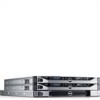Dell PowerVault NX3500 Hardware Owner's Manual - Page 25
Check CPU or
 |
View all Dell PowerVault NX3500 manuals
Add to My Manuals
Save this manual to your list of manuals |
Page 25 highlights
Table 1-3. LCD Status Messages (continued) Code E1311 E1313 E1410 E1414 E1418 E141C Text Causes Corrective Actions Fan module ## RPM exceeding range. Check fan. RPM of specified fan in specified module is outside of intended operating range. See "Troubleshooting System Cooling Problems" on page 96. Fan redundancy The system is no longer lost. Check fan redundant. Another fans. fan failure would put the system at risk of over-heating. Check LCD for additional scrolling messages. See "Troubleshooting a Fan" on page 97. Internal Error Specified processor has an Remove AC power to the detected. internal error. The error system for 10 seconds and Check "FRU X". may or may not have been restart the system. caused by the processor. If the problem persists, see "Getting Help" on page 113. CPU # temp exceeding range. Check CPU heatsink. Specified processor is out Ensure that the processor of acceptable temperature heat sink is properly range. installed. See "Troubleshooting the Processor" on page 102 and "Troubleshooting System Cooling Problems" on page 96. CPU # not detected. Check CPU is seated properly. Specified processor is missing or bad, and the system is in an unsupported configuration. Ensure that the specified microprocessor is properly installed. See "Troubleshooting the Processor" on page 102. Unsupported Processor is in an CPU unsupported configuration. configuration. Check CPU or BIOS revision. Ensure that your processor matches and conforms to the type described in the processor technical specifications outlined in your system's Getting Started Guide. About Your Solution 25















